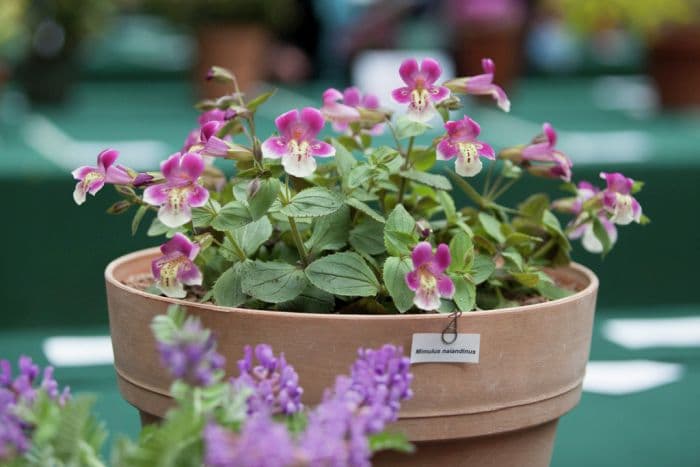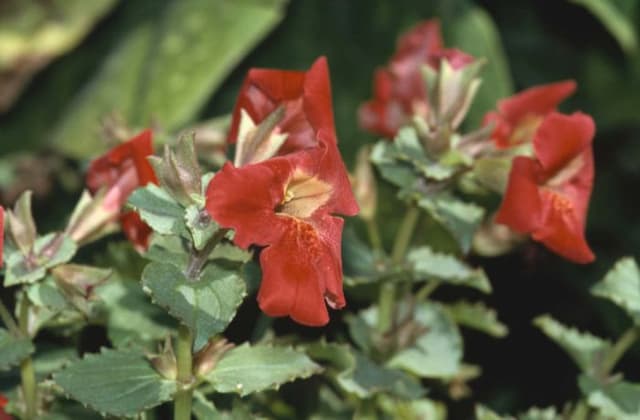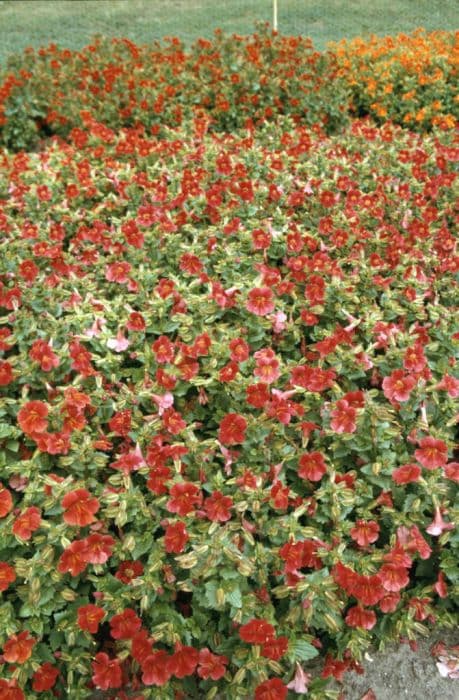Monkey Flower Mimulus naiandinus

ABOUT
Mimulus naiandinus, commonly referred to as the monkey flower, is a striking plant that showcases a rich blend of colors and unique floral characteristics. The flowers are the most distinctive feature, typically vivid and two-lipped, resembling a monkey's face, which is how the plant received its endearing common name. These showy blooms may come in a variety of shades, including yellow, orange, red, or pink, sometimes with speckled or splotched patterns that add to their visual appeal. The leaves of the monkey flower are usually green, with a shape that ranges from ovate to lanceolate, and they can have either smooth or serrated edges. The plant forms a lush foliage that creates a vibrant backdrop for the ornamental flowers. In some cases, the green of the leaves contrasts with the flowers, making them stand out even more. This combination of dramatic flowers and verdant leaves allows the monkey flower to capture the attention of onlookers and serves as a favorite for garden enthusiasts looking for a pop of color.
About this plant
 Names
NamesFamily
Phrymaceae
Synonyms
Monkey Flower, Sticky Monkey Flower
Common names
Mimulus naiandinus
 Toxicity
ToxicityTo humans
Monkey Flower (Mimulus naiandinus) is not widely known to be toxic to humans. There is limited information on its toxicity, so it is advised to avoid ingesting any part of the plant, especially in the absence of conclusive data. If proven toxic, the symptoms could potentially include gastrointestinal upset, such as nausea, vomiting, and diarrhea. It is always prudent to treat unknown plants with caution and keep them out of the reach of children who might accidentally ingest them.
To pets
Monkey Flower (Mimulus naiandinus) does not have a known record of being highly toxic to pets. Similar to the precautions for humans, due to the lack of specific toxicity information, it is wise to prevent pets from ingesting any part of the plant. If toxicity were to be identified, symptoms could resemble those of other mild poisonings, including vomiting, diarrhea, or drooling. Always keep an eye on your pet's behavior and consult a veterinarian if you suspect they have eaten a potentially harmful plant.
 Characteristics
CharacteristicsLife cycle
Perennials
Foliage type
Deciduous
Color of leaves
Green
Flower color
Varies
Height
2 feet (0.61 meters)
Spread
2 feet (0.61 meters)
Plant type
Herb
Hardiness zones
9
Native area
Australia
Benefits
 General Benefits
General Benefits- Aesthetic Appeal: Mimulus naiandinus, commonly known as monkey flower, is appreciated for its vibrant and unique flowers which add color and visual interest to gardens and landscapes.
- Ecosystem Support: The monkey flower provides nectar for pollinators such as bees, butterflies, and hummingbirds, supporting local ecosystems and promoting biodiversity.
- Low Maintenance: Monkey flowers are generally easy to care for, requiring minimal upkeep once established, making them suitable for gardeners of all skill levels.
- Drought Tolerance: Many Mimulus species are adapted to withstand drought conditions, making monkey flowers an excellent choice for water-conservative landscaping in arid environments.
- Soil Versatility: Monkey flowers can grow in a variety of soil types, including poor soils, which allows them to be planted in different garden settings without requiring extensive soil amendment.
- Fast Growth: Monkey flowers typically have a fast growth rate, allowing gardeners to quickly enjoy their blooms after planting.
 Medical Properties
Medical PropertiesThis plant is not used for medical purposes.
 Air-purifying Qualities
Air-purifying QualitiesThis plant is not specifically known for air purifying qualities.
 Other Uses
Other Uses- Mimulus naiandinus, commonly known as Monkey Flower, can be used as a natural dye for textiles, providing a range of colors from yellow to green depending on the mordant used.
- In permaculture design, Monkey Flower can function as an insectary plant, attracting pollinators and beneficial insects to the garden which helps to maintain a healthy ecosystem.
- With its unique appearance, this plant is often used for educational purposes to demonstrate the diversity of floral adaptations and pollination strategies.
- The plant can be utilized in landscaping for erosion control due to its rooting system that holds soil effectively on slopes.
- Monkey Flower serves as an ornamental plant for water features or rain gardens as it thrives in moist environments.
- Some cultures use the blossoms of Monkey Flower to dress up dishes and drinks as an edible decoration, although they do not have a notable taste.
- The flowers of Monkey Flower can be pressed and utilized in craft projects such as in the making of natural jewelry or decorative bookmarks.
- It's sometimes used in horticultural therapy programs for its ease of care and vibrant colors which are thought to have a mood-lifting effect.
- Monkey Flower can be a source of nectar for homemade syrups, although it is not a common use and might require significant quantities.
- Photographers and artists may utilize Monkey Flower as a subject due to its bright color and intriguing shape, making it ideal for artistic inspiration.
Interesting Facts
 Feng Shui
Feng ShuiThe Monkey Flower is not used in Feng Shui practice.
 Zodiac Sign Compitability
Zodiac Sign CompitabilityThe Monkey Flower is not used in astrology practice.
 Plant Symbolism
Plant Symbolism- Courage: Commonly known as Monkey Flower, Mimulus naiandinus often symbolizes courage due to its association with mimulus genus, representing the strength to face one's fears.
- Playfulness: The quirky, almost grinning appearance of the Monkey Flower blooms reflects a sense of playfulness and joy.
- Peace: The soothing colors and harmonious presence of the Monkey Flower can symbolize peace and calmness in chaos.
- Protection: In folklore, some believed that carrying Monkey Flower could provide spiritual protection and ward off negativity.
 Water
WaterMonkey flower (the common name for Mimulus naiandinus) prefers consistently moist soil, so it should be watered regularly. In general, provide approximately 1 inch of water per week, but adjust based on weather conditions—more during hot, dry periods and less during cool, wet spells. Water deeply at the soil level to encourage deep root growth while avoiding water on the foliage to prevent disease. During the growing season, check the soil moisture frequently and water when the top inch feels dry to the touch. In winter, reduce watering but do not allow the soil to completely dry out.
 Light
LightMonkey flower thrives in bright, indirect light with protection from harsh afternoon sun. It is best positioned in a spot that gets morning sunlight and dappled shade in the afternoon. An east- or north-facing window would be ideal indoors, while a partially shaded spot is optimal for outdoor growth to ensure vibrant blooms and healthy foliage.
 Temperature
TemperatureMonkey flower prefers moderate temperatures, thriving ideally in a range between 60 to 75 degrees Fahrenheit. It can tolerate a minimum temperature down to 50 degrees Fahrenheit and a maximum of 80 degrees Fahrenheit, but prolonged exposure outside this range may stress the plant.
 Pruning
PruningMonkey flower benefits from pruning to encourage bushier growth and more blooms. Trim back the tips of the stems regularly, especially after a flush of blooms has faded, to promote a second flowering. The best time for more extensive pruning is in early spring before new growth starts.
 Cleaning
CleaningAs needed
 Soil
SoilFor the best soil mix for Monkey Flower (Mimulus naiandinus), use a well-draining, fertile soil with a pH between 6.0 and 7.5. A mix of loam, peat, and coarse sand should provide the necessary drainage and nutrients.
 Repotting
RepottingMonkey Flowers do not require frequent repotting and can be repotted every 1-2 years, or when the plant outgrows its current pot, to ensure they have enough room to grow.
 Humidity & Misting
Humidity & MistingMonkey Flower thrives in moderate to high humidity levels, ideally between 50-70%, to mimic their natural, moist habitat.
 Suitable locations
Suitable locationsIndoor
Ensure bright, indirect light and maintain humidity for Monkey Flower indoors.
Outdoor
Plant in partial shade with moist soil for Monkey Flower outdoors.
Hardiness zone
9-11 USDA
 Life cycle
Life cycleMimulus naiandinus, also known as monkey flower, begins its life cycle when seeds germinate, typically in spring or after a wet period, when the soil is moist and temperatures are mild. The seedlings emerge and grow into juvenile plants with characteristic opposite leaves. As they mature, monkey flowers develop stems that may either stand erect or recline along the ground, establishing a more extensive root system. The plant then enters a flowering stage, producing vibrant, tubular flowers that attract pollinators and are capable of self-pollination. Following pollination, monkey flower sets seed within capsule-like fruits, which dry and release seeds for the next generation. Finally, as an annual or a short-lived perennial, depending on the conditions, Mimulus naiandinus completes its life cycle by dying back, while its seeds persist in the soil to germinate and begin the cycle anew.
 Propogation
PropogationPropogation time
Spring-Early Summer
Propogation: Mimulus naiandinus, commonly known as Monkey Flower, can be most effectively propagated through seed. The ideal time for sowing Monkey Flower seeds is in the early spring, right after the last frost has passed, ensuring a warm and stable growing environment. To propagate, the seeds should be lightly sprinkled onto the surface of a well-draining soil mix in a flat or container, as they require light to germinate. The soil should be kept moist but not waterlogged. Placing the container in a warm area with temperatures around 70°F (21°C) will promote germination. Seedlings usually emerge in 10 to 14 days and can be transplanted to individual pots when they are large enough to handle safely, usually when they have several sets of true leaves.

